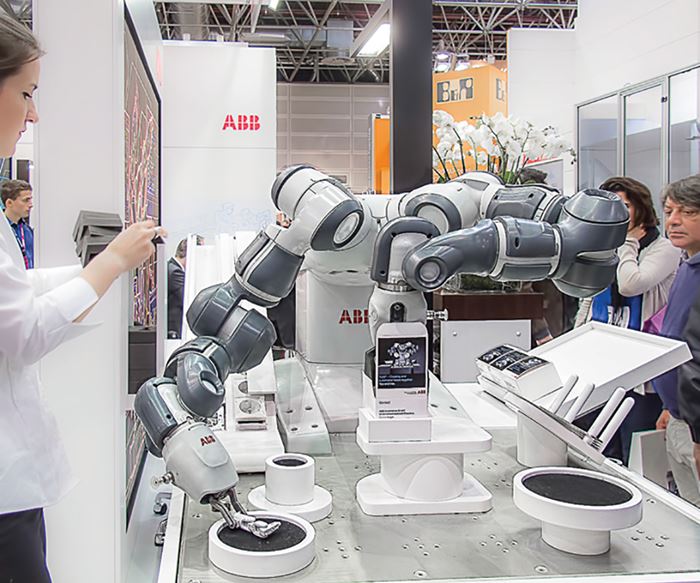Making Standard Robots More “Collaborative”
Laser scanners can slow or stop a robot temporarily when a human approaches.
One of the many themes at October’s K 2016 show in Dusseldorf was getting robots to work more closely—and safely—with humans. On the one hand, suppliers introduced new models of so-called “collaborative” robots, or “cobots,” such as the small tabletop assembly model, dubbed YuMi (pictured), from ABB Automation (U.S. office in Auburn Hills, Mich.). Fanuc Automation (Rochester Hills, Mich.), Kuka Robotics (Shelby Township, Mich.), and Universal Robots (E. Setauket, N.Y.) also showed six-axis cobots.
Meanwhile, suppliers showed how to allow technicians access to robots without shutting them down altogether. Both Sytrama, sister company of Negri Bossi (New Castle, Del.), and Staubli Robotics (U.S. office in Duncan, S.C.) demonstrated robots that use compact laser scanners to sense the presence of humans. When a technician approaches within a certain distance, the robot continues its cycle, but at a much reduced speed, which Staubli calls Safe Limited Speed (SLS). Coming even closer can cause the robot to slow further and finally stop completely (Safe Operating Stop, or SOS). It starts up again instantly when the person moves away a certain distance. Staubli’s new generation of TX2 six-axis robots (pictured) use the same principle to define a Safe Zone around the end-of-arm tooling to prevent collisions with inanimate obstacles. These models also have a sensory skin, which when touched immediately brings the robot to a halt.
Sources at both Sytrama and Staubli agree that even with the laser scanner, some sort of physical barrier is still necessary to prevent accidental encroachments from hindering robot operations, but full-height guarding may no longer be needed with this safety feature. One maker of the laser scanners is Sick AG in Germany (U.S. office in Minneapolis). It is the yellow object at the bottom of the photo with the Staubli robot.
Related Content
-
A Cost Saving Modular Approach to Resin Drying Automation
Whether implementing a moisture-sensing closed-loop system for a single dryer, or automating an entire plant, technology is available to take the guesswork and worry out of resin drying. Using a modular approach allows processors to start simple and build more capabilities over time.
-
Real-Time Production Monitoring as Automation
As an injection molder, Windmill Plastics sought an economical production monitoring system that could help it keep tabs on its shop floor. It’s now selling the “very focused” digital supervisor it created, automating many formerly manual tasks.
-
How Was K 2022 for Blow Molding?
Over a dozen companies emphasized sustainability with use of foam and recycle, lightweighting and energy savings, along with new capabilities in controls, automation and quick changeovers.















